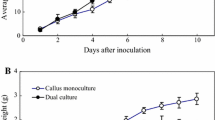Summary
Artemisia annua L. is the source of a potent antimalarial, artemisinin. As part of a program to produce artemisinin through tissue culture, a series of 14 multifactorial experiments were conducted to determine suitable conditions for initiating and maintaining friable callus fromA. annua. In the first six experiments, three different nutrient formulations [Gamborg B5 (B5), Murashige and Skoog (MS), and Whetmore and Rier (WR)], each with 32 combinations of auxins and cytokinins [2,4-dichlorophenoxyacetic acid (2,4-D) with benzyladenine (BA), or 1-naphthaleneacetic acid (NAA) with 6-furfurylaminopurine (kinetin)], were tested. Both B5 and WR nutrients supported friable callus formation from leaf explants with some combinations of auxin and cytokinin. Inasmuch as friable callus seemed to be produced over a wider range of auxin and cytokinin concentrations in combination with B5, the remaining experiments were conducted solely with this nutrient formulation. In the remaining eight experiments, it was determined that friable callus formed when combinations of NAA with kinetin or 2,4-D and BA were used with B5 medium. Lighter colored, more friable callus formed in response to 2,4-D and BA than with NAA and kinetin. No single combination of concentrations of auxin and cytokinin seemed to be “ideal” for producing friable callus. Ranges of 2,4-D from 0.5 to 2.0 with BA between 0.025 and 0.1, or NAA between 0.5 and 2.0 with kinetin between 0.5 and 1.0 mg/liter, produced acceptable results.
Similar content being viewed by others
References
Avery, M. A.; Chong, W. K. M.; Jenningswhite, C. Stereoselective total synthesis of (+)-artemisinin, the antimalarial constituent ofArtemisia annua L. J. Am. Chem. Soc. 114:974–979; 1992.
Chen, H.; Chen, F.; He, X. Cited in Martinez and Staba (11).
DiCosmo, F.; Misawa, M. Eliciting secondary metabolism in plant cell cultures. Trends Biotech. 3:318–322; 1985.
Elhag, H. M.; El-Domiaty, M. M.; El-Feraly, F. S., et al. Selection and micropropagation of high artemisinin producing clones ofArtemisia annua L. Phytotherapy Res. 6:20–24; 1992.
Fowler, M. W. Industrial applications of plant cell culture. In: Yeoman, M. M., ed. Plant cell culture technology. London: Blackwell Scientific Publications; 1986:202–227.
Francois, G.; Desombere, I.; Hendrix, L., et al. The production of antimalarial compounds by tissue cultures ofArtemisia annua. Physiol. Plant. 79:A103; 1990.
Gamborg, O. L.; Miller, R. A.; Ojima, K. Nutrient requirements of suspension cultures of soybean root cells. Exp. Cell Res. 50:151–158; 1968.
Haigh, J. R.; Linden, J. C. Plant cell culture production of artemisinin. Biotechnology 31; 1990.
He, X.; Zeng, M.; Li, G., et al. cited in Martinez and Staba (11).
Klayman, D. L. Qinghaosu (Artemisinin): an antimalarial drug from China. Science 228:1049–1055; 1985.
Martinez, B. C.; Staba, E. J. The production of artemisinin inArtemisia annua L. tissue cultures. Adv. Cell Cult. 6:69–88; 1988.
Murashige, T.; Skoog, F. A revised medium for rapid growth and bioassays with tobacco cultures. Physiol. Plant. 15:473–497; 1962.
Nair, M. S. R.; Acton, N.; Klayman, D. L., et al. Production of artemisinin in tissue cultures ofArtemisia annua. J. Nat. Prod. (Lloydia) 49:504–507; 1986.
Ramaswamy, R. Synthetic peptides in malaria research. Peptide Res. 4:210–219; 1991.
Roth, R. J.; Acton, N. A simple conversion of artemisic acid to artemisinin. J. Nat. Prod. (Lloydia) 52:1183–1185; 1989.
Schmid, G.; Hofheinz, W. Total synthesis of qinghaosu. J. Am. Chem. Soc. 105:624–625; 1983.
Sturchler, D. How much malaria is there worldwide? Parasitol. Today 5:39–40; 1989.
Tawfiq, N. K.; Anderson, L. A.; Roberts, M. F., et al. Antiplasmodial activity ofArtemisia annua plant cell cultures. Plant Cell Rep. 8:425–428; 1989.
Whetmore, R. H.; Rier, J. P. Experimental induction of vascular tissue in callus of angiosperms. Am. J. Bot. 50:418–430; 1963.
Whipkey, A.; Simon, J. E.; Charles, D. J., et al. In vitro production of artemisinin fromArtemisia annua. Hortscience 26:728; 1991.
Xu, X. X.; Zhu, J.; Huang, D-Z., et al. Total synthesis of arteannuin and deoxyarteannuin. Tetrahedron 42:819–828; 1986.
Author information
Authors and Affiliations
Rights and permissions
About this article
Cite this article
Basile, D.V., Akhtari, N., Durand, Y. et al. Toward the production of artemisinin through tissue culture: Determining nutrient-hormone combinations suitable for cell suspension cultures. In Vitro Cell Dev Biol - Plant 29, 143–147 (1993). https://doi.org/10.1007/BF02632286
Received:
Accepted:
Issue Date:
DOI: https://doi.org/10.1007/BF02632286




